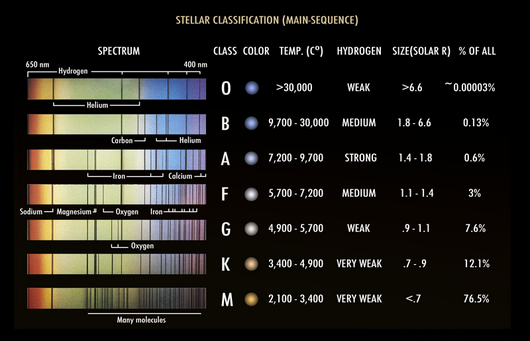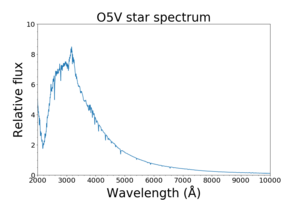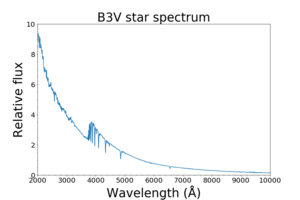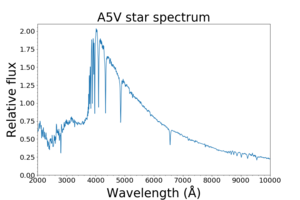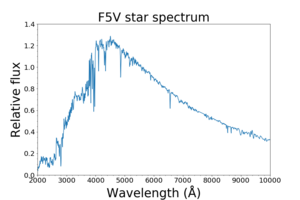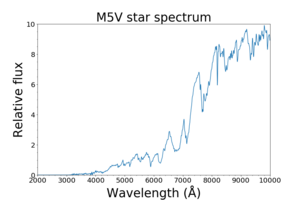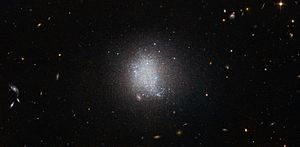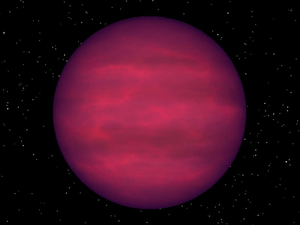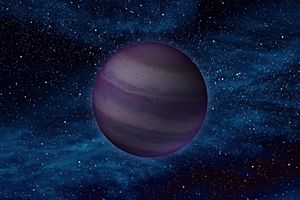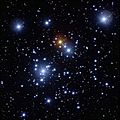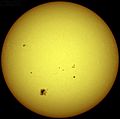Stellar classification facts for kids
In astronomy, stellar classification is how scientists group stars. They sort stars mainly by their temperature. You can tell a star's temperature by looking at its light spectrum (the colors it shines).
Stars are also put into spectral types or classes based on their color. A star's temperature usually decides its color, from red (coolest) to blue-white (hottest). Spectral types are named with a letter. The seven main types are M, K, G, F, A, B, and O. Type O stars are the hottest, and M type stars are the coolest.
Each letter class is then divided using a number from 0 to 9. Here, 0 means hottest and 9 means coolest. For example, A8, A9, F0, and F1 go from hotter to cooler. This system has grown to include other stars and star-like objects. For instance, class D is for white dwarfs, and classes S and C are for carbon stars.
Contents
- How Scientists Classify Stars
- History of Star Classification
- Types of Stars by Spectrum
- Newer Star Classifications
- Stars and the Search for Life
- Related Pages
- Images for kids
- See also
How Scientists Classify Stars
Scientists use different ways to classify stars. The two main systems are the Harvard system and the Yerkes system.
The Harvard System: Sorting Stars by Temperature
The Harvard system was created by astronomer Annie Jump Cannon. It groups stars by their light features, using single letters and numbers. Main-sequence stars (like our Sun) have surface temperatures from about 2,000 to 50,000 K. Older, more developed stars can be hotter than 100,000 K. These classes show the star's atmosphere temperature, usually listed from hottest to coldest.
| Class | Temperature | Color | Size (compared to Sun) | Brightness (compared to Sun) | Hydrogen Lines | How Common |
|---|---|---|---|---|---|---|
| O | 30,000 K or more | Blue | 16 times bigger or more | 30,000 times brighter or more | Weak | 0.00003% |
| B | 10,000–30,000 K | Bluish white | 1.8–6.6 times bigger | 25–30,000 times brighter | Medium | 0.12% |
| A | 7,500–10,000 K | White | 1.4–1.8 times bigger | 5–25 times brighter | Strong | 0.61% |
| F | 6,000–7,500 K | Yellowish white | 1.15–1.4 times bigger | 1.5–5 times brighter | Medium | 3.0% |
| G | 5,200–6,000 K | Yellow | 0.96–1.15 times bigger | 0.6–1.5 times brighter | Weak | 7.6% |
| K | 3,700–5,200 K | Light orange | 0.7–0.96 times bigger | 0.08–0.6 times brighter | Very weak | 12% |
| M | 2,400–3,700 K | Orangish red | 0.7 times bigger or less | 0.08 times brighter or less | Very weak | 76% |
A fun way to remember the order of the spectral types, from hottest to coolest, is: "Oh, Be A Fine Guy/Girl: Kiss Me!"
The spectral classes O through M are further divided by numbers (0–9). A 0 means the hottest stars in that class. For example, A0 is hotter than A9. Sometimes, fractional numbers are used, like O9.7. Our Sun is classified as G2.
Scientists didn't fully understand that the Harvard classification showed a star's temperature until later. In the 1920s, physicist Meghnad Saha developed a theory about how atoms in stars become ionized. Then, astronomer Cecilia Payne showed that the O-B-A-F-G-K-M sequence is indeed a temperature sequence.
The Yerkes System: Sorting Stars by Brightness
The Yerkes spectral classification, also called the MK (Morgan-Keenan) system, was introduced in 1943. It was developed by William Wilson Morgan, Philip C. Keenan, and Edith Kellman. This system looks at lines in a star's light that are sensitive to both temperature and surface gravity. Surface gravity is linked to how bright a star is. The Harvard system only uses surface temperature.
Stars that are denser and have stronger surface gravity show wider spectral lines. A giant star has much lower gravity on its surface than a dwarf star of similar mass. This is because giants are much larger. So, differences in a star's light can show how bright it is. This allows scientists to assign a "luminosity class" just by looking at the star's spectrum.
The table below lists different luminosity classes.
| Luminosity Class | Description | Examples |
|---|---|---|
| 0 or Ia+ | hypergiants (extremely bright supergiants) | Cygnus OB2#12 |
| Ia | Luminous supergiants | Eta Canis Majoris |
| Iab | Medium-bright supergiants | Gamma Cygni |
| Ib | Less bright supergiants | Zeta Persei |
| II | Bright giants | Beta Leporis |
| III | Normal giants | Arcturus |
| IV | subgiants | Gamma Cassiopeiae |
| V | Main-sequence stars (dwarfs) | Achernar |
| sd (prefix) or VI | subdwarfs | HD 149382 |
| D (prefix) or VII | white dwarfs | van Maanen 2 |
Sometimes, a star might be in between two classes. For example, a star might be a supergiant or a bright giant. In these cases, special symbols are used:
- A slash (/) means the star is either one class or the other.
- A dash (-) means the star is in between the two classes.
For example, a star classified as A3-4III/IV is between spectral types A3 and A4, and is either a giant or a subgiant.
Special Features in Star Spectra
Scientists can add small letters after a star's spectral type to show unusual features in its light.
| Code | What it means |
|---|---|
| : | Unsure spectral value |
| ... | Has special features not yet described |
| ! | Very special feature |
| comp | Light from more than one star mixed together |
| e | Shows emission lines (light being given off) |
| [e] | Shows "forbidden" emission lines (unusual light given off) |
| er | Emission lines with weaker centers |
| eq | Emission lines with a special shape (P Cygni profile) |
| f | Shows N III and He II emission |
| f* | N IV 4058Å line is stronger than N III lines |
| f+ | Si IV 4089Å & 4116Å lines are emitted, plus N III |
| f? | C III 4647–4650–4652Å emission lines are as strong as N III |
| (f) | N III emission, but He II absorption is weak or missing |
| ((f)) | Strong He II absorption with weak N III emissions |
| h | WR stars with hydrogen emission lines |
| ha | WR stars with hydrogen seen in both absorption and emission |
| He wk | Weak Helium lines |
| k | Shows absorption features from interstellar space |
| m | Has more metal features than usual |
| n | Broad absorption lines because the star is spinning fast |
| nn | Very broad absorption lines |
| neb | Light from a nebula is mixed in |
| p | Unspecified unusual feature (peculiar star) |
| pq | Unusual light, similar to novae |
| q | Shows P Cygni profiles |
| s | Narrow absorption lines |
| ss | Very narrow lines |
| sh | Features of a Shell star |
| var | Features in the light change over time (sometimes "v") |
| wl | Weak lines (also "w" & "wk") |
| Element symbol |
Abnormally strong lines of that element |
| z | Shows an unusually strong ionized helium line at 468.6 nm |
For example, 59 Cygni is classified as B1.5Vnne. This means it's a B1.5V star with very broad absorption lines and certain emission lines.
History of Star Classification
The strange order of letters in the Harvard classification (O, B, A, F, G, K, M) is due to history. It grew from earlier systems and changed as scientists learned more.
Early Secchi Classes
In the 1860s and 1870s, Angelo Secchi, a pioneer in studying star light, created the Secchi classes. By 1866, he had three classes of star spectra.
By the late 1890s, the Harvard classification began to take over from Secchi's system.
| Class Number | Secchi Class Description |
|---|---|
| Secchi class I | White and blue stars with strong hydrogen lines, like Vega. This includes modern A and early F stars. |
| Secchi class I (Orion subtype) |
A type of Secchi class I with narrow lines, like Rigel. These are modern early B-type stars. |
| Secchi class II | Yellow stars with weaker hydrogen but clear metal lines, like the Sun. This includes modern G, K, and late F stars. |
| Secchi class III | Orange to red stars with complex bands of light, like Betelgeuse. This matches modern M stars. |
| Secchi class IV | In 1868, he found carbon stars. These are red stars with strong carbon bands, matching modern C and S classes. |
| Secchi class V | In 1877, he added a fifth class: stars with emission lines, like Gamma Cassiopeiae. In 1891, Edward Charles Pickering suggested this class should be modern O stars. |
The Draper System
In the 1880s, astronomer Edward C. Pickering started surveying star spectra at the Harvard College Observatory. The first result was the Draper Catalogue of Stellar Spectra in 1890. Williamina Fleming classified most of the stars in this catalog. She classified over 10,000 stars and found 10 novae and more than 200 variable stars.
This catalog used a system where Secchi's classes were divided into more specific lettered classes from A to P. Q was for stars that didn't fit anywhere else. Fleming worked with Pickering to sort 17 different classes based on how strong hydrogen absorption lines were. This system was later changed by Annie Jump Cannon and Antonia Maury to create the Harvard system we use today.
The Old Harvard System (1897)
In 1897, another Harvard astronomer, Antonia Maury, put the Orion subtype of Secchi class I ahead of the rest of Secchi class I. This meant modern type B stars came before modern type A stars. She used numbers (I–XXII) instead of letters for her 22 types.
| Groups | Summary |
|---|---|
| I−V | Included 'Orion type' stars with increasing hydrogen absorption lines from group I to group V |
| VI | A middle group between 'Orion type' and Secchi type I |
| VII−XI | Secchi's type 1 stars, with decreasing hydrogen absorption lines |
| XIII−XVI | Secchi type 2 stars with decreasing hydrogen absorption lines and increasing metal lines |
| XVII−XX | Secchi type 3 stars with increasing spectral lines |
| XXI | Secchi type 4 stars |
| XXII | Wolf–Rayet stars |
Maury also added lowercase letters to show more details about the lines:
- (a): average width
- (b): hazy
- (c): sharp
Antonia Maury published her own star classification catalog in 1897. It included 4,800 photographs and her analysis of 681 bright northern stars. This was the first time a woman was fully credited for an observatory publication.
The Current Harvard System (1912)
In 1901, Annie Jump Cannon went back to using letters. She kept only O, B, A, F, G, K, M, in that order. She also used P for planetary nebulae and Q for some unusual spectra. She used types like B5A for stars halfway between B and A.
Finally, by 1912, Cannon changed the types to B0, A0, B5, F2, and so on. This is pretty much the Harvard classification system used today. She developed this system by looking at photographic plates that turned starlight into readable spectra.
Types of Stars by Spectrum
The system for classifying stars is like how species are classified in biology. Each category is defined by one or more standard stars and a description of their unique features.
"Early" and "Late" Stars
Stars are often called early or late types. "Early" means hotter, and "late" means cooler.
These terms can be used in general or to compare stars. "Early" in general refers to O or B, and maybe A stars. When comparing, "early K" might mean K0, K1, K2, and K3 stars.
"Late" is used the same way. Generally, it means K and M stars. But it can also mean stars that are cool compared to others, like "late G" for G7, G8, and G9.
In the relative sense, "early" means a lower number after the class letter, and "late" means a higher number.
This old way of speaking comes from a 19th-century idea about how stars change. People thought stars started hot ("early-type") and cooled down ("late-type"). We now know stars are powered by nuclear fusion, but the terms "early" and "late" stuck around.
Class O Stars: Super Hot and Bright
O-type stars are super hot and incredibly bright. Most of their light is in the ultraviolet range. These are the rarest main-sequence stars. Only about 1 in 3,000,000 (0.00003%) of the main-sequence stars near our Sun are O-type. Some of the most massive stars belong to this group.
O-type stars have strong lines of ionized helium and other elements like silicon, oxygen, nitrogen, and carbon. They also have hydrogen lines, though not as strong as in cooler stars. Because they are so massive, O-type stars have very hot cores and burn their hydrogen fuel very quickly. This means they are the first stars to leave the main sequence.
Examples:
- O7V – S Monocerotis
- O9V – 10 Lacertae
Class B Stars: Very Luminous and Blue
B-type stars are very bright and blue. Their light shows neutral helium lines, strongest at the B2 subclass, and medium hydrogen lines. Since O- and B-type stars use so much energy, they don't live very long. They usually stay close to where they formed, unless they are runaway stars.
About 1 in 800 (0.125%) of the main-sequence stars near our Sun are B-type. They are not very common, and the closest one is Regulus, about 80 light-years away.
Some massive B-type stars, called Be stars, show hydrogen lines that emit light. These stars often have strong stellar winds, high surface temperatures, and lose a lot of mass because they spin very fast.
Examples:
- B0V – Upsilon Orionis
- B0Ia – Alnilam
- B3V – Eta Ursae Majoris
- B5Ia – Eta Canis Majoris
- B8Ia – Rigel
Class A Stars: White or Bluish-White
A-type stars are common stars you can see with your eyes. They are white or bluish-white. They have very strong hydrogen lines, strongest at A0. They also have lines of ionized metals like iron, magnesium, and silicon. Calcium lines also become stronger here. About 1 in 160 (0.625%) of the main-sequence stars near our Sun are A-type.
Examples:
Class F Stars: Yellowish White
F-type stars have stronger "H" and "K" spectral lines of calcium. Neutral metals like iron and chromium start to become as strong as ionized metal lines by late F. Their light is known for weaker hydrogen lines and ionized metals. Their color is white. About 1 in 33 (3.03%) of the main-sequence stars near our Sun are F-type. This includes Procyon A, which is within 20 light-years.
Examples:
- F0Ib – Alpha Leporis
- F2V – 78 Ursae Majoris
- F9V – Beta Virginis
Class G Stars: Yellow, Like Our Sun
G-type stars, including our Sun, have clear "H" and "K" spectral lines of calcium, strongest at G2. They have even weaker hydrogen lines than F stars. They show both ionized and neutral metals. There's also a strong spike from cyanide molecules. G-class main-sequence stars make up about 7.5% (nearly one in thirteen) of the main-sequence stars near our Sun.
Class G also has the "Yellow Evolutionary Void." Supergiant stars often change between blue (O or B) and red (K or M). When they do this, they don't stay long in the unstable yellow supergiant class.
Examples:
- G0V – Beta Canum Venaticorum
- G2V – Sun
- G5V – Kappa1 Ceti
- G8V – 61 Ursae Majoris
Class K Stars: Orangish and Cooler
K-type stars are orangish and a bit cooler than the Sun. They make up about 12% of the main-sequence stars near our Sun. There are also giant K-type stars, from hypergiants like RW Cephei to giants and supergiants like Arcturus. Orange dwarfs, like Alpha Centauri B, are main-sequence stars.
They have very weak hydrogen lines, if any. They mostly show neutral metals like manganese, iron, and silicon. By late K, molecular bands of titanium monoxide appear. Scientists think these stars might be good places for life to develop on orbiting planets. This is because they have a wide habitable zone and less harmful radiation than hotter stars.
Examples:
- K0V – Sigma Draconis
- K0III – Pollux
- K2V – Epsilon Eridani
- K5V – 61 Cygni A
Class M Stars: The Most Common and Coolest
Class M stars are by far the most common. About 76% of the main-sequence stars near our Sun are M-class. However, M-class main-sequence stars (red dwarfs) are so dim that you usually can't see them without a telescope. The brightest M-class main-sequence star known is Lacaille 8760, which is barely visible to the naked eye.
Even though most M-class stars are red dwarfs, many of the largest supergiant stars in the Milky Way are M-class, like VY Canis Majoris, Antares, and Betelgeuse. Also, some larger, hotter brown dwarfs are late M-class.
The light from an M-class star shows lines from oxide molecules (especially TiO) and all neutral metals. Hydrogen absorption lines are usually missing. TiO bands can be very strong in M-class stars, often dominating their visible light by about M5.
Examples:
- M0IIIa – Beta Andromedae
- M2III – Chi Pegasi
- M1-M2Ia-Iab – Betelgeuse
- M2Ia – Mu Cephei
Newer Star Classifications
Scientists have added new spectral types for recently discovered kinds of stars.
Hot Blue Emission Stars
The light from some very hot, bluish stars shows strong emission lines from carbon, nitrogen, or sometimes oxygen.
Class WR: Wolf–Rayet Stars

Wolf–Rayet stars (class W or WR) were once grouped with O-type stars. They are special because their light lacks hydrogen lines. Instead, their light is dominated by wide emission lines of highly ionized helium, nitrogen, carbon, and sometimes oxygen. Scientists think these are mostly dying supergiants whose outer hydrogen layers have been blown away by strong stellar winds, showing their hot helium cores.
WR stars are divided into subclasses based on the strength of nitrogen and carbon emission lines:
- WN – light dominated by N III-V and He I-II lines
- WNE (WN2 to WN5) – hotter
- WNL (WN7 to WN9) – cooler
- WN/C – WN stars with strong C IV lines (in between WN and WC)
- WC – light with strong C II-IV lines
- WCE (WC4 to WC6) – hotter
- WCL (WC7 to WC9) – cooler
- WO (WO1 to WO4) – strong O VI lines; very rare and extremely hot (up to 200,000 K)
About 10% of the central stars of planetary nebulae (CSPNe) are hydrogen-poor and show WR spectra. These are low-mass stars. To tell them apart from massive Wolf–Rayet stars, their spectra are put in square brackets: e.g., [WC].
Slash Stars
Slash stars are O-type stars that have lines in their light similar to WN stars. They get their name because their spectral type is written with a slash (e.g., "Of/WNL").
Cool Red and Brown Dwarf Classes
New spectral types L, T, and Y were created to classify the infrared light from cool stars. This includes both red dwarfs and brown dwarfs, which are very dim in visible light.
Brown dwarfs are objects that aren't massive enough to start hydrogen fusion (like true stars). They cool down as they age, moving through the L, T, and Y spectral classes. The less massive they are, the faster they cool.
Class L Dwarfs
Class L dwarfs are named because they are cooler than M stars, and L is the next letter alphabetically. Some L dwarfs are massive enough to be stars, but most are substellar (brown dwarfs). They are a very dark red and brightest in infrared light. Their atmospheres are cool enough for metal hydrides and alkali metals to show up strongly in their light.
Class T Dwarfs
Class T dwarfs are cool brown dwarfs with surface temperatures between about 550 and 1,300 K (277 and 1,027 °C; 530 and 1,880 °F). Their light peaks in the infrared. Methane is very clear in their spectra.
Scientists believe there should be many more stars in our galaxy than we've found. They think many of these might be main-sequence stars or brown dwarfs of the L and T classes, which are hard to see.
Class Y Dwarfs
Brown dwarfs of spectral class Y are even cooler than T-class dwarfs. Their light looks different from T-dwarfs. As of 2013, 17 objects were placed in class Y. These dwarfs have been found within forty light-years by the Wide-field Infrared Survey Explorer (WISE).
The light from these Y objects shows absorption around 1.55 micrometers. Some scientists think this is due to ammonia absorption, which could define the T-Y transition. However, this feature is hard to tell apart from absorption by water and methane.
The coolest Y dwarf known is WISE 0855−0714, with a temperature of about 250 K (colder than freezing water!) and a mass only seven times that of Jupiter. Y dwarfs can range from 9 to 25 Jupiter masses. Young Y objects might even be less than one Jupiter mass, meaning they can be planets.
Late Giant Carbon-Star Classes
Carbon-stars are stars whose light shows they produce carbon. This carbon is a byproduct of triple-alpha helium fusion. As carbon increases, the light from these stars changes from the usual G, K, and M classes. The equivalent classes for carbon-rich stars are S and C.
Scientists think the giants among these stars make their own carbon. But some are double stars, where the carbon might have come from a companion star that is now a white dwarf.
Class C Stars
These are also known as carbon stars. They are red giants nearing the end of their lives, with extra carbon in their atmospheres. The old R and N classes were similar to normal G to M stars. These have been reclassified into a single carbon class C. Most known carbon stars are giants or supergiants. There are several types:
- C-R – Similar to late G- to early K-type stars.
- C-N – Similar to late K- to M-type stars.
- C-J – A type of cool C star with a lot of 13C.
- C-H – Older stars similar to C-R stars.
- C-Hd – Carbon stars with less hydrogen.
Class S Stars
Class S stars are in between M stars and carbon stars. Those like M stars have strong ZrO absorption bands, similar to the TiO bands in M stars. Those like carbon stars have strong sodium lines and weak C2 bands. Class S stars have extra zirconium and other elements. Like carbon stars, almost all known S-class stars are asymptotic-giant-branch stars (a late stage of stellar evolution).
The spectral type is S, followed by a number from zero to ten. This number shows the star's temperature, similar to M-class giants. The most common types are S3 to S5.
Classes MS and SC: In-Between Carbon Stars
Stars that are in between M and S classes are called MS stars. Similarly, stars between S and C-N classes are called SC or CS. Scientists believe the sequence M → MS → S → SC → C-N shows how carbon increases in these stars as they age.
White Dwarf Classifications
Class D (for Degenerate) is the modern way to classify white dwarfs. These are low-mass stars that have stopped nuclear fusion and shrunk to the size of planets, slowly cooling down. Class D is further divided into types like DA, DB, DC, DO, DQ, DX, and DZ. These letters show what the white dwarf's outer layer or atmosphere is made of.
Here are the white dwarf types:
- DA – rich in hydrogen, with strong hydrogen lines.
- DB – rich in helium, with neutral helium lines.
- DO – rich in helium, with ionized helium lines.
- DQ – rich in carbon, with carbon lines.
- DZ – rich in metals, with metal lines.
- DC – no strong lines from the above categories.
- DX – lines are not clear enough to classify.
A number follows the type, showing the white dwarf's surface temperature. This number is a rounded form of 50400 divided by the temperature in kelvins. For example, DA1.5 for IK Pegasi B.
If a white dwarf shows more than one feature, two or more type letters can be used.
Special White Dwarf Features
White dwarfs use a different set of symbols for special features:
| Code | What it means |
|---|---|
| P | Magnetic white dwarf with detectable polarization |
| E | Emission lines present |
| H | Magnetic white dwarf without detectable polarization |
| V | Variable (changes) |
| PEC | Has special features |
Non-Star Classifications: P and Q
Classes P and Q are left over from the system developed by Cannon. They are sometimes used for objects that are not stars: Type P objects are stars inside planetary nebulae (usually young white dwarfs); type Q objects are novae.
Stars and the Search for Life
While humans might one day be able to colonize any kind of star system, this section looks at how likely life is to appear around other stars.
For a star system to support life, factors like stability, brightness, and how long the star lives are important. We only know of one star that hosts life, our G-class Sun. Our Sun has many heavy elements and doesn't change much in brightness. Our Solar System is also unusual because it only has one star.
Based on what we know from Earth, the types of stars that might support life are limited. For main-sequence stars, those more than 1.5 times the Sun's mass (O, B, and A types) age too quickly for advanced life to develop. On the other hand, dwarfs less than half the Sun's mass (M type) might cause planets in their habitable zone to become "tidally locked" (one side always faces the star), which creates other problems for life. Even with these challenges, many scientists study red dwarf systems because there are so many of them and they live for a very long time.
Because of these reasons, NASA's Kepler Mission looks for habitable planets around nearby main-sequence stars that are less massive than A-type stars but more massive than M-type stars. This means the most likely stars to host life are dwarf stars of types F, G, and K.
Related Pages
Images for kids
-
The Sun, a G2 main-sequence star, with dark sunspots
See also
 In Spanish: Clasificación estelar para niños
In Spanish: Clasificación estelar para niños


